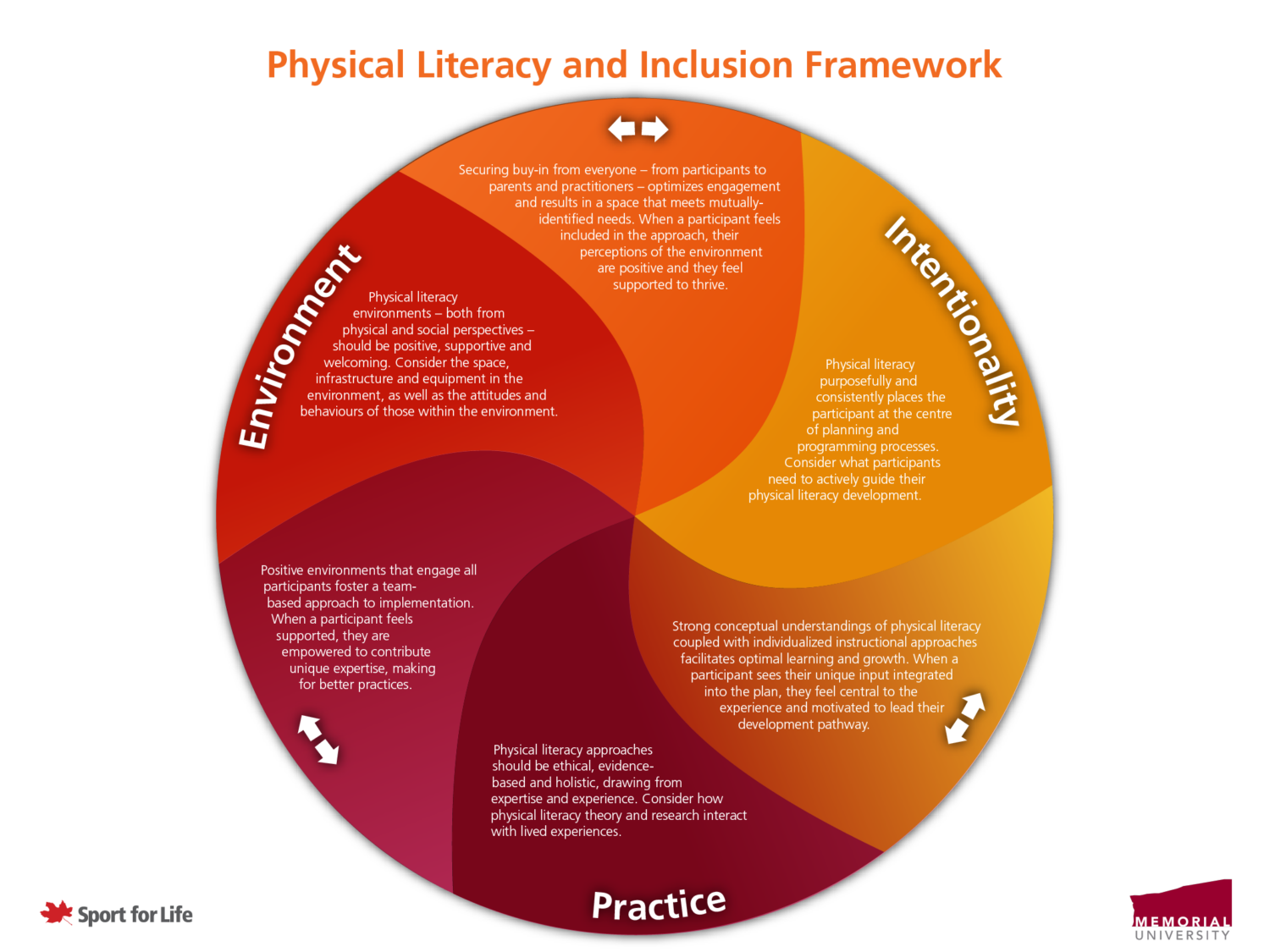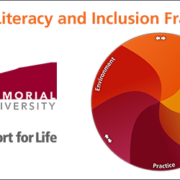Pillars to physical literacy and inclusion: Participants must be afforded opportunities for choice, empowerment, and autonomy according to THEIR needs/desires
Many programs have implemented physical literacy (PL) but often overlook the experiences of persons with diverse abilities due to societal, cultural, and political influences. This can lead to exclusion and marginalization from physical activities. Researchers at Memorial University have addressed this challenge by developing a PL and inclusion framework through direct observation of programming and perspectives from participants of diverse abilities, parents, practitioners, and program administrators. The framework and its three pillars of environment, practice and intentionality offer one lens to support the development of current and future inclusive physical literacy programs.

This blog series will discuss the ten evidence-based best practices for the inclusion of persons with diverse abilities in programming suggested within their research findings. From holistic design to systems of support and everything in between, find out how to foster inclusion in your programs.
Idealization: Participants must be afforded opportunities for choice, empowerment, and autonomy according to THEIR needs/desires. This is accomplished through providing opportunities for active exploration within the physical activity context.
By offering opportunities for choice, empowerment, and autonomy, participants are more engaged and motivated to actively explore physical activities that resonate with them. This active exploration allows individuals to take ownership of their physical literacy development, cultivating a positive and lasting relationship with physical activity.
When participants feel supported and empowered, they are encouraged to contribute their unique expertise, leading to improved practices. Creating a collaborative and inclusive environment where their perspectives are valued enables practitioners to tailor their approaches to meet individual needs better.
Putting into practice
Meet Coach Charlie, a dedicated volunteer sport coach who leads an outdoor adventure sports program for individuals experiencing disabilities, including both physical and cognitive disabilities. Charlie believes in empowering her participants by providing opportunities for choice and active exploration within the context of physical activities.
At the beginning of the program, Charlie takes the time to get to know each participant individually. They assess each individual’s preferences, comfort levels, and specific goals related to outdoor adventure sports. Charlie conducts one-on-one discussions with each participant and their caregivers to understand their needs and desires. Some participants may prefer hiking, while others may be interested in rock climbing or kayaking. Charlie respects these individual preferences and tailors the program accordingly.
Charlie involves participants in the planning process by organizing group meetings where they can suggest and discuss the activities they’d like to explore during the program. They facilitate brainstorming sessions where participants share their ideas for outdoor adventures. Charlie and the participants decide on various activities to include in the program, ensuring that everyone’s interests are considered.
Charlie encourages active exploration and hands-on experiences during each activity. She ensures that participants are actively involved in setting up equipment, making choices, and solving challenges. For instance, during a hiking trip, Charlie empowers participants by involving them in route planning, map reading, and decision-making about rest stops. This approach allows participants to actively engage with the environment and gain a sense of autonomy.
Charlie understands that some participants may require adaptive support to exercise their autonomy effectively. They provide the necessary assistance while allowing the participants to make choices within their abilities. For participants with mobility challenges, Charlie may arrange for adaptive equipment like all-terrain wheelchairs, ensuring they can actively participate in outdoor activities alongside their peers.
By affording participants opportunities for choice, empowerment, and autonomy within the program, Charlie fosters a sense of ownership and enthusiasm for outdoor adventure sports. Participants not only engage in physical activities for the long term but also develop self-confidence and a deep connection with the outdoors. This example demonstrates how a volunteer community-based sport coach can ensure the principle of providing opportunities for choice, empowerment, and autonomy according to participants’ needs and desires, achieved through active exploration within the context of physical activities for individuals experiencing disabilities.
Tangible takeaways
To nurture opportunities for choice, empowerment, and autonomy that align with participants’ needs and desires, consider implementing the following recommendations:
- Diverse Activity Menu: Offer a diverse and inclusive menu of physical activity options that cater to various interests, abilities, and preferences. Allow participants to choose activities that align with their passions and comfort levels, empowering them to take ownership of their experiences.
- Individualized Goal Setting: Engage participants in setting personalized goals within the physical activity context. Collaborate with them to identify aspirations and tailor activities to help them achieve these objectives, fostering a sense of empowerment and autonomy over their development.
- Inclusive Adaptations: Provide adaptations and modifications to accommodate diverse needs and abilities. Ensure that all participants can actively explore and engage in the activities, making the experience accessible to everyone.
- Informed Decision-Making: Ensure participants can access information about the various physical activity options available. Facilitate informed decision-making by clearly explaining what each activity entails and the potential benefits, enabling participants to make choices that align with their needs and desires.
- Flexible Participation Offer flexibility in participation, allowing participants to choose their level of involvement and commitment to activities. Some individuals may prefer regular engagement, while others may opt for occasional participation, and both choices should be respected.
- Participant-Led Activities: Encourage participant-led activities where they have the opportunity to design, lead, and organize sessions with guidance and support from facilitators. This approach fosters empowerment and autonomy while cultivating leadership skills.
- Supportive Facilitators: Train facilitators to be supportive and nurturing, empowering participants to take the lead in their physical activity experiences. Facilitators should act as guides, helping participants explore and discover their interests and capabilities.
- Ongoing Feedback Loop: Establish a continuous feedback loop with participants, allowing them to share their experiences, preferences, and suggestions for improvement. Actively incorporate their feedback into program design and implementation, demonstrating their input is valued.
By implementing these recommendations, organizations can cultivate an environment where participants have the freedom to make choices, explore activities actively, and feel empowered to shape their physical literacy journey according to their unique needs and desires. This approach aligns with Sport for Life principles and fosters inclusive physical literacy experiences that cater to the diverse aspirations of all participants.
This article is one of a series of posts on the Sport for Life website based on the research conducted by Drs. Kyle Pushkarenko and Jeff Crane of Memorial University. Keep an eye on our blog for information on the ten suggested best practices and ways to take action around them over the coming months.

